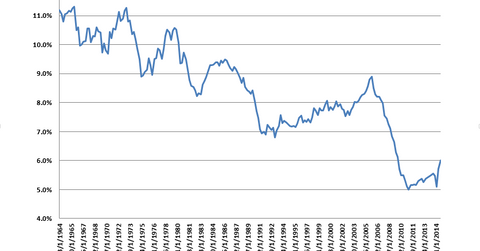The Importance of Construction Spending to GDP
Historically, construction spending has led economies out of recessions. This didn’t happen in the most recent recession, however, because of the overhang from the real estate bubble.
Sept. 17 2015, Updated 8:16 a.m. ET

Construction spending is a critical component of economic performance
Each month, the U.S. Census Bureau releases its Value of Construction Put in Place survey. It measures the total dollar value of construction work in the United States.
The survey covers both public and private construction spending. This includes new structures as well as improvements to existing structures. The data include the cost of labor, materials, architectural work, engineering work, overhead, interest, taxes, and contractor profits.
Historically, construction spending has led economies out of recessions. This didn’t happen in the most recent recession, however, because of the overhang from the real estate bubble.
Historical housing starts data have averaged ~1.5 million units per year since the 1950s. Prior to the bust, a sub-900,000 print on housing starts was seen as a terrible number, something only seen at the depths of a recession. For much of the recovery, 900,000 starts have been a dream. When you take into account population growth, the numbers become even more striking.
Take a look at the above chart and note the decline in construction spending as a percentage of GDP (gross domestic product). You can clearly see the drop-off after the housing bubble burst. Construction spending, especially residential construction, employs a lot of people, so there’s a big economic multiplier.
Homebuilders may be changing their demographic focus
Homebuilders like Lennar (LEN) and Toll Brothers (TOL) have been able to coast by on tight inventory and increasing sales prices. Given the well-known problems with the first-time homebuyer—student loan debt, a tight job market—builders have focused more on the move-up and luxury buyer.
The builders with more of an entry level focus, such as PulteGroup (PHM) and D.R. Horton (DHI), are beginning to focus more on the lower price points in anticipation of the return of the first-time homebuyer. Investors who want to bet on the sector as a whole should look at the SPDR S&P Homebuilders ETF (XHB).
